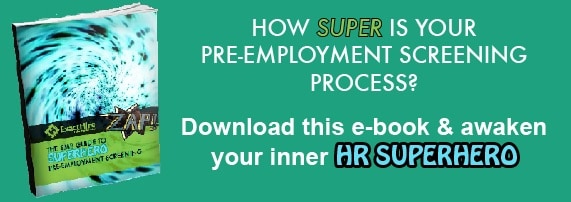Template for a Consistent, Effective Hiring Process – Whiteboard [VIDEO]
A consistent, effective hiring process is a critical factor when selecting and onboarding employees for your organization. In this whiteboard video, Jeff Hallam of ExactHire discusses how to create a template for a successful process, including the use of tools such as background checking and reference checking.
Video Transcript:
Hi there, and welcome to another edition of ExactHire Whiteboard Video Chat. I’m Jeff Hallam and today we’re going to talk about how to create a template for a consistent and effective hiring process. And this predominantly applies to small- to mid-sized organizations, and that’s who we work with for the most part. And this is something that when you’re working for a Fortune 500 organization, a lot of these things are already set in stone and you don’t really have much of an opportunity to change those nor debate them. But for many of these organizations that aren’t at that level, the issue of how do we hire, what does it look like and how do we make sure it’s consistent time after time…can be a little elusive because there may not be a person who spearheads that, and/or that person may not have communicated things very effectively up to that point. And so following a handful of very simple things and making sure that there are a few items in place can really help you in your endeavors to make things much better from a hiring perspective.
So the first one is, as you understand what it is that you want to do, make sure that everybody internally who is going to be involved in that process understands what it is, what the steps are, who is going to be involved and what that is going to look like over time. And once everybody understands that, it really sets a groundwork for everything that is going to happen from there. And I know that seems simple, but that miscommunication or lack of communication is usually the number one culprit for why things don’t work the way folks might like in today’s world.
Likewise, once that’s been set, it becomes very easy for people who are involved in the cycle…and I’ve been guilty of this myself in prior worlds…to want to shortcut the process. This is a really hot candidate, this is a really important job…we have to fill it very quickly. We don’t have time to do these things that we have normally done…and as tempting as that is, and understand you have to have some flexibility, understand there will be exceptions. But as much as you can, try to take this process that’s been communicated and defined and avoid that temptation. Try to keep it in place as much as you can…it can really avoid the notion of everybody thinking their job is the exception.
So once you have that platform, and you understand this is kind of what we want it to look like, there are some elements that most everybody agrees should be part of any best practice that you would consider for hiring. And we’ve just listed those here, and very briefly, they start in order of beginning of the process on forward at the front of the train with relevant job descriptions. Unfortunately, a lot of people still use job descriptions the way they did twenty-five, thirty, forty years ago. Very long, very detailed, very lengthy lists of things that somebody has to have, must do, etc. And frankly those are things that candidates just aren’t paying much attention to. What they want is a quick, little bulleted list of: what is this job; what do I need to have to be qualified for it; so that they can make a good quick decision as to whether they are even interested in learning more.
Once you’ve gotten them past that, the next step becomes how can you make it simple for them to let you know they’re interested in the job? When we were in the throes of the recession, employers could ask for a full online application, multiple sets of references, everything except somebody’s first born child it seemed and they would get plenty of applicants. And that’s because people were desperate for work. But now that that’s reversed and is nearly 180 degrees the other way, applicants are very much the ones setting that tone. And they’re not going to, in most cases, be willing to give you a full online application, let alone a full written application, just for the privilege of being considered for your opening. So really give some thought to what you can do to automate that number one, and number two, to only get what you need initially and then perhaps get the rest later. That’s very much a trend we’re seeing and there are a lot of ways that you can do that. So it’s definitely something worth considering.
One of the biggest issues that we see for most organizations is this inability to keep candidates apprised of where they are in the process. Having them know where they are, what the next step is, are they moving forward, if not, make them aware of it, if so, what does that next step look like and what is the timing for it… I cannot stress how important that is. It’s the number one complaint from most candidates and that the easiest way to protect your employment brand is to not let them feel like their resume or application fell into a black hole. Let them know where they are, keep them posted as they go through your cycle.
Something that’s been around for a long time and people sometimes will almost just treat this as a, “yes, I’m done” type of endeavor is checking references. This is another item that’s even become automated now. There are lots of ways that you can make this much more quick, simple, much less laborious. The key to that is making sure that there is consistency there. Much like everything else we are talking about here…make sure the same questions are asked, make sure the feedback is recorded in the same format. Not just for ease of access, but also to give you a point to go back to over time to find out where things might have been missed. Understanding what somebody has done in prior environments can be an invaluable way to get a better feel for how well they are likely to do in your environment.
And finally, performing background checks. As funny is this might be, initially, this is the thought for a lot of people…”I hope they don’t see this,” “I hope they don’t find out I did that,” etc. People have a lot of skeletons in their closet for better or worse, and certainly not everyone, but a much higher percentage of the population than you might think. So dependent upon your organization and what your needs are, making sure that you understand how they’ve done before, and is there anything that could potentially create exposure for your organization if you hire this person, again, are very necessary pieces that have to be in there.
So when think about this notion of, how do I create this template, how do I make my process consistent and more effective, following these three steps…get everybody on board, make sure there is something that keeps everybody from short-cutting what you’ve put in place, and then making sure that some of these key best practices are there as part of that cycle will definitely help you and your organization, not only make the process more consistent, but overall help you hire better.









